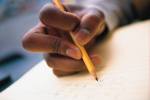
<When writing on unlined paper with his eyes closed, the second grade student's letters are 3/4 inch high. The space on the worksheet is unlined and allows for 1/4 inch high letters.
Problem: When a child writes letters with their eyes closed either for fun or for professional observation, the height of the letters produced can represent the “comfort level” of his finger movements. If the height of the letters are 3/4 inch, this is more appropriate for a kindergarden student than for a second grade student. As he must tighten down his fingers to place the letter in the worksheet’s smaller space, hand fatigue and decreased writing speed can result.
Solution: Copy the worksheet allowing for larger spaces or allow the writing on an extra page. If ask to write on the back of the worksheet, two problems appear: 1. usually there are no lines on the back. We all write better with lines. 2. Flipping the worksheet from front to back and then back to the front can be very distracting as well as taxing on the child’s memory as he attempts to remember the question and answer, flip the sheet and then write.
To help with improving the size of his writing, a program such as “Callirobics” (www.callirobics.com) may be helpful. Also it would be important to look at his pencil grip which may be a cause (though not only) of the larger writing.






